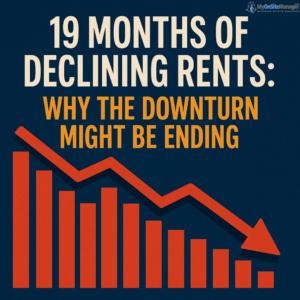For the past year and a half, renters across the United States have enjoyed a rare break: rents have been steadily falling, month after month. According to recent data from Realtor.com, February 2025 marked the 19th consecutive month of year-over-year declines in median asking rents across the nation’s 50 largest metropolitan areas. But behind the headlines lies a complex story about construction, supply, and where the rental market might be headed next.
Source: Realtor.com – Rent Prices Continue Dropping Across the U.S.
The Numbers at a Glance
-
National Median Rent: In February 2025, the median asking rent fell to $1,691—a $15 decrease (or -0.9%) compared to the same time last year.
-
By Unit Type:
-
Studios: Down 0.8% YoY
-
1-Bedroom Units: Down 0.7%
-
2-Bedroom Units: Down 0.7%
-
These dips, while not huge, are significant given the market’s rapid run-up over the past several years. And although rents are softening in the short term, they remain 14.4% higher than they were five years ago, reflecting the long-term impact of inflation and housing shortages during the pandemic.
Why Are Rents Falling?
The cooling of rent prices is tightly linked to new rental construction. Over the past two years, many cities saw a boom in multifamily housing developments, which added thousands of new rental units to the market—particularly in fast-growing metros like Austin, Phoenix, and Charlotte.
With more rental options available, landlords have had to compete harder to fill vacancies, leading to more price flexibility, rent concessions (like free months or reduced deposits), and—most importantly—lower asking prices.
But this influx of supply might be short-lived.
A Slowdown in Construction Could Reverse the Trend
While renters are currently benefiting from an expanded housing supply, fewer new developments are breaking ground. In fact, 2024 marked the slowest year for multifamily building permits since 2017. This means that in many markets, the pipeline of new apartments is drying up. Once the current crop of newly built units is absorbed, we could return to a familiar pattern: demand outpacing supply.
Cities that continue to issue permits and support multifamily development may see continued downward pressure on rents, but in most areas, the slowdown in construction signals that the rent relief may be temporary.
What This Means for Different Groups
For Renters:
-
Short-Term Win: Now is a good time to negotiate leases or look for deals, especially in cities where large apartment complexes are opening.
-
Keep an Eye on the Market: With construction slowing, rent growth could resume by late 2025 or early 2026.
-
Consider Longer Leases: Locking in a lease now could help shield you from potential rent hikes later.
For Landlords:
-
A Competitive Environment: You may need to offer incentives or price adjustments to keep units occupied in the short term.
-
Prepare for Recovery: As the rental market tightens again, especially in undersupplied regions, rental income and property value could rise.
For Investors and Developers:
-
Construction Timing Is Key: Projects that break ground now may be well-positioned for a potential supply crunch 12–24 months down the road.
-
Location Matters: Focus on metros with growing populations and limited permitting activity for the best long-term returns.
What to Watch in the Coming Months
-
Building Permit Trends: Fewer permits = fewer future units = tighter market.
-
Occupancy Rates: As new apartments fill up, rent prices may start inching up again.
-
Local Policy Changes: Cities introducing rent control or zoning reforms may shift the balance.
Final Thoughts
The rental market is currently in a rare moment of relief, but this phase may not last long. With fewer new projects breaking ground and urban demand expected to rebound, rent prices could rise again in many cities by the end of the year.
If you’re a renter, it might be the perfect time to shop around. If you’re a landlord or investor, now’s the time to plan strategically—because the pendulum may be swinging back.
Original Source: Realtor.com: Rents Continue To Cool Across Most of the U.S.—Unless You Live in These Places

